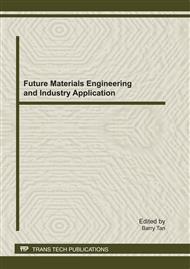[1]
Johansson A. K., Korte H., Yang B.R. Stanley J. C. and Kallio H. P, Sea buckthorn berry oil inhibits platelet aggregation, J. Nutr. Biochem. vol. 11, Oct. 2000, pp.491-495.
DOI: 10.1016/s0955-2863(00)00105-4
Google Scholar
[2]
Baoru Yang and Heikki Kallio, Composition and physiological effects of sea buckthorn (Hippophae) lipids, Trends in Food Science & Technology, vol. 13, May. 2002, pp.160-167.
DOI: 10.1016/s0924-2244(02)00136-x
Google Scholar
[3]
Partanen R., Yoshii H., Kallio H., Yang B. and Pirkko F, Encapsulation of sea suckthorn kernel oil in modified starches, JAOCS, vol. 79, Dec. 2002, pp.219-223.
DOI: 10.1007/s11746-002-0464-z
Google Scholar
[4]
[Gibbs B.F., Kermasha S., Alli I. And Mulligan C.N., Encapsulation in the food industry: A Review, Int. J. Food Sci. Nutr, vol. 50, May. 1999, pp.213-224.
Google Scholar
[5]
Stephan Drusch S., Serfert R. and Schwarz K, Microencapsulation of fish oil with n-octenylsuccinate-derivatised starch: Flow properties and oxidative stability, Eur. J. Lipid Sci. Technol, vol. 108, May. 2006, pp.501-512.
DOI: 10.1002/ejlt.200500312
Google Scholar
[6]
Rawat R and Burgess D.J., Effect of ethanol as a processing co-solvent on the PLGA microsphere characteristics, International Journal of Pharmaceutics, vol. 394, May. 2010, pp.99-105.
DOI: 10.1016/j.ijpharm.2010.05.013
Google Scholar
[7]
Zolnik B.S. and Burgess D.J., Effect of acidic pH on PLGA microsphere degradation and release, Journal of Controlled Release, vol. 122, May. 2007, pp.338-344.
DOI: 10.1016/j.jconrel.2007.05.034
Google Scholar
[8]
LAN T., HAO H., BI M., LI T. and ZHAO Y. L, A study on preparation of plla microspheres, Journal of Northwest University (Natural Science Edition), China, vol. 38, Aug. 2008, pp.584-586.
Google Scholar
[9]
YANG F., LIN Y., TAN Z.Y., ZHAO Y. M, and MAI H Z., Study on the Erythromycin Polylactic Acid Microspheres for Lung Targeting, Journal of China Pharmaceutical University, China, vol. 33, 2002, pp.21-215.
Google Scholar
[10]
Cui C. J, Steven P. Schwendeman, One-Step Surface Modification of Poly (lactide-co-glycolide) Microparticles with Heparin, Pharmaceutical Research, vol. 24, Dec. 2007, pp.2381-2393.
DOI: 10.1007/s11095-007-9378-1
Google Scholar
[11]
Cucheval A. and Chow R.C.Y., A study on the emulsification of oil by power ultrasound, Ultrasonics Sonochemistry, vol. 15, Jan. 2008, pp.916-920.
DOI: 10.1016/j.ultsonch.2008.02.004
Google Scholar
[12]
SAH H., Microencapsulation thchniques using ethyl acetate as a dispersed solvent effects of its extraction rate on the characteristics of PLGA microspheres, J Controlled Release, vol. 47, Jan. 1997, pp.233-245.
DOI: 10.1016/s0168-3659(97)01647-7
Google Scholar
[13]
MENG F. T., MA G. H. and QIU W., W/O/W double emulsion technique using ethyl acetate as organic solvent effects of its diffusion rate on the characteristics of microparticles, J Controlled Release, vol. 91, Feb. 2003, pp.407-416.
DOI: 10.1016/s0168-3659(03)00273-6
Google Scholar


